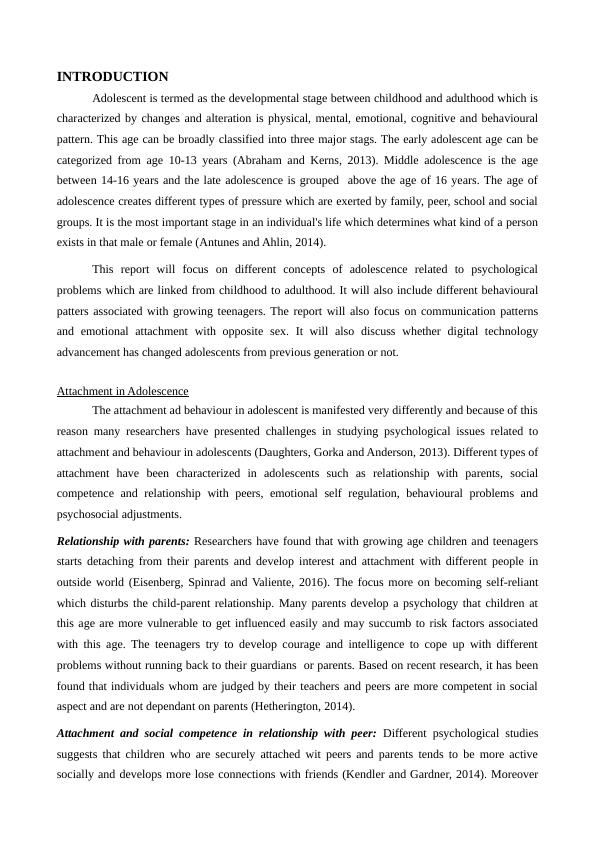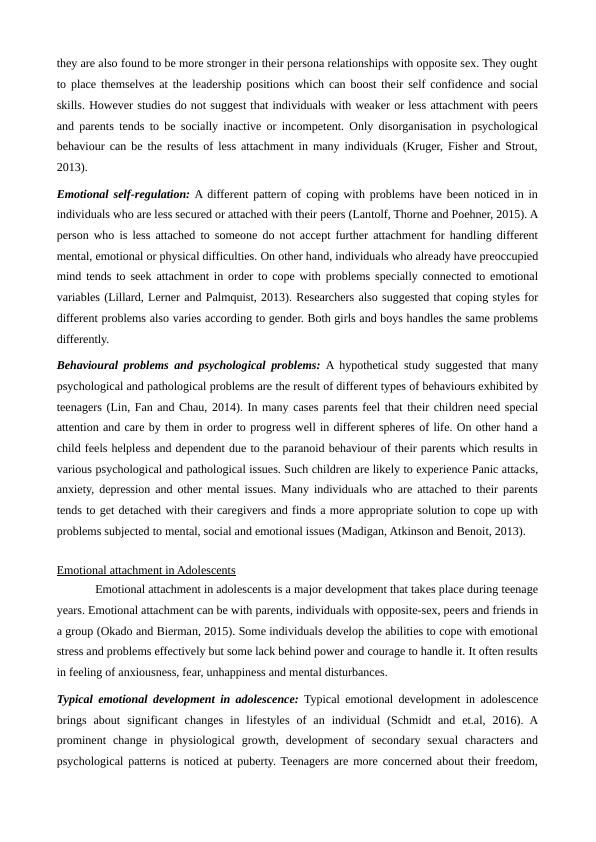Psychology in the early years and adolescent
11 Pages4210 Words215 Views
Added on 2020-01-07
Psychology in the early years and adolescent
Added on 2020-01-07
ShareRelated Documents
Psychology in the early years andadolescent

Table of ContentsINTRODUCTION................................................................................................................................3Attachment in Adolescence.............................................................................................................3Emotional attachment in Adolescents..............................................................................................4Communication in Adolescence......................................................................................................6Identity in Adolescence....................................................................................................................7Has expansion of digital technology changed adolescent different from previous generations......8CONCLUSION....................................................................................................................................9REFERENCES...................................................................................................................................10

INTRODUCTIONAdolescent is termed as the developmental stage between childhood and adulthood which ischaracterized by changes and alteration is physical, mental, emotional, cognitive and behaviouralpattern. This age can be broadly classified into three major stags. The early adolescent age can becategorized from age 10-13 years (Abraham and Kerns, 2013). Middle adolescence is the agebetween 14-16 years and the late adolescence is grouped above the age of 16 years. The age ofadolescence creates different types of pressure which are exerted by family, peer, school and socialgroups. It is the most important stage in an individual's life which determines what kind of a personexists in that male or female (Antunes and Ahlin, 2014).This report will focus on different concepts of adolescence related to psychologicalproblems which are linked from childhood to adulthood. It will also include different behaviouralpatters associated with growing teenagers. The report will also focus on communication patternsand emotional attachment with opposite sex. It will also discuss whether digital technologyadvancement has changed adolescents from previous generation or not.Attachment in AdolescenceThe attachment ad behaviour in adolescent is manifested very differently and because of thisreason many researchers have presented challenges in studying psychological issues related toattachment and behaviour in adolescents (Daughters, Gorka and Anderson, 2013). Different types ofattachment have been characterized in adolescents such as relationship with parents, socialcompetence and relationship with peers, emotional self regulation, behavioural problems andpsychosocial adjustments.Relationship with parents: Researchers have found that with growing age children and teenagersstarts detaching from their parents and develop interest and attachment with different people inoutside world (Eisenberg, Spinrad and Valiente, 2016). The focus more on becoming self-reliantwhich disturbs the child-parent relationship. Many parents develop a psychology that children atthis age are more vulnerable to get influenced easily and may succumb to risk factors associatedwith this age. The teenagers try to develop courage and intelligence to cope up with differentproblems without running back to their guardians or parents. Based on recent research, it has beenfound that individuals whom are judged by their teachers and peers are more competent in socialaspect and are not dependant on parents (Hetherington, 2014).Attachment and social competence in relationship with peer: Different psychological studiessuggests that children who are securely attached wit peers and parents tends to be more activesocially and develops more lose connections with friends (Kendler and Gardner, 2014). Moreover

they are also found to be more stronger in their persona relationships with opposite sex. They oughtto place themselves at the leadership positions which can boost their self confidence and socialskills. However studies do not suggest that individuals with weaker or less attachment with peersand parents tends to be socially inactive or incompetent. Only disorganisation in psychologicalbehaviour can be the results of less attachment in many individuals (Kruger, Fisher and Strout,2013).Emotional self-regulation: A different pattern of coping with problems have been noticed in inindividuals who are less secured or attached with their peers (Lantolf, Thorne and Poehner, 2015). Aperson who is less attached to someone do not accept further attachment for handling differentmental, emotional or physical difficulties. On other hand, individuals who already have preoccupiedmind tends to seek attachment in order to cope with problems specially connected to emotionalvariables (Lillard, Lerner and Palmquist, 2013). Researchers also suggested that coping styles fordifferent problems also varies according to gender. Both girls and boys handles the same problemsdifferently.Behavioural problems and psychological problems: A hypothetical study suggested that manypsychological and pathological problems are the result of different types of behaviours exhibited byteenagers (Lin, Fan and Chau, 2014). In many cases parents feel that their children need specialattention and care by them in order to progress well in different spheres of life. On other hand achild feels helpless and dependent due to the paranoid behaviour of their parents which results invarious psychological and pathological issues. Such children are likely to experience Panic attacks,anxiety, depression and other mental issues. Many individuals who are attached to their parentstends to get detached with their caregivers and finds a more appropriate solution to cope up withproblems subjected to mental, social and emotional issues (Madigan, Atkinson and Benoit, 2013).Emotional attachment in Adolescents Emotional attachment in adolescents is a major development that takes place during teenageyears. Emotional attachment can be with parents, individuals with opposite-sex, peers and friends ina group (Okado and Bierman, 2015). Some individuals develop the abilities to cope with emotionalstress and problems effectively but some lack behind power and courage to handle it. It often resultsin feeling of anxiousness, fear, unhappiness and mental disturbances.Typical emotional development in adolescence: Typical emotional development in adolescencebrings about significant changes in lifestyles of an individual (Schmidt and et.al, 2016). Aprominent change in physiological growth, development of secondary sexual characters andpsychological patterns is noticed at puberty. Teenagers are more concerned about their freedom,

End of preview
Want to access all the pages? Upload your documents or become a member.
Related Documents
Childhood and Adolescence | Reportlg...
|9
|2035
|12
Assignment on Psychological Perspective Healthlg...
|9
|2157
|88
Name of the university: A transitional phase from childhood to adulthoodlg...
|13
|3529
|331
Growth and Developmentlg...
|12
|1225
|472
Developmental Psychology Article Matrix 2022lg...
|6
|1179
|29
Psychology Evolutionary Theory 2022lg...
|6
|1454
|14
